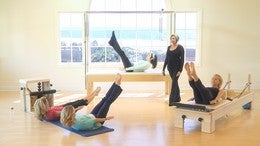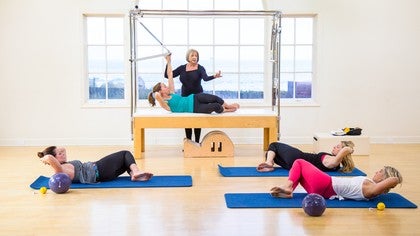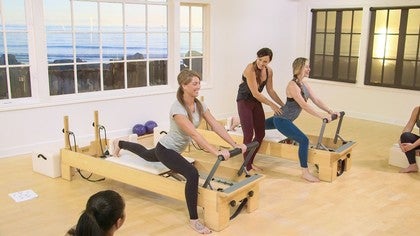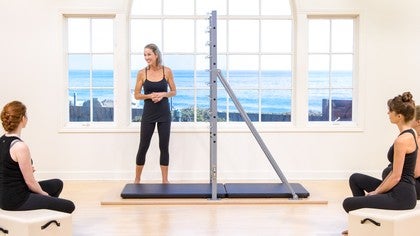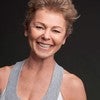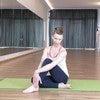Description
About This Video
Transcript
Read Full Transcript
Hi, I'm here with Jackie and my course today is going to be a little bit, um, different and, and I think interesting because it is really based on the essence of Pele's. Um, so many times from the master teachers I was taught don't teach exercise, teach concepts of the work and in the concept of the work that is to make the exercise work for the person and not have the person work the exercise. So in other words, what we want to do is to look at the body and make the exercise successful for the person in front of us. So what I like to do is to look at exercises that people enjoy doing, people things that they really like and things that they don't like. When I would do my sessions with master teacher Kathy Grant, she would say to me, now, Kathy, go home and only do the ones that you're really bad at.
You don't need the other ones. And I'll go, Oh God, I hate those exercises. And she goes, that's what we have to find out. Why? Why do you hate the exercises? Why do you love the other exercises? So in this program, what we want to do is look at what we love and what we hate and kind of change that around so that what we want to do is see why you really liked that exercise and take it down to its very essence and why you hate the other ones and take them down to their essence and try to find the common denominator between the two. So that what we're going to do is find out where they meet and how we can make the things that you don't like really fun for you to do.
So they will become your best exercises. The ones that we want to work on today. The things that you liked, Jackie and you like the uh, the series of five. Yeah. And it's so funny, Kathy grant used to say, I don't get it. They're all the same exercise that we're all because really we're doing the same thing. We have this stability through the pelvis and the stability in the core muscles.
And the legs are either going this way or this way or this way or this way. But really it's about kind of the same thing until we get to crisscross where we add that upper body rotation but we still have the state same stability through the pelvic alignment. So we are going to work on those things today. And then the exercise you really don't like is rolling like a ball. Well I have to tell you my story of rolling like a ball.
It was one that I hated. I really thought it was a really stupid exercise because, and this is the truth promise not to repeat it to anyone. I would in my first lessons were all back and roll up real back and reel up and roll back. And by number five I was facing the back of the room and honest to God, I thought that when I got really good in my five repetitions, I'd go all the way around because everybody else was still facing the front of the room. But in actuality what was happening is my scoliosis, my the left side of my back never touched the mat. And I was just powering through it.
And so it took me many years to learn where that exercise comes from, how to get more mobility through my spine and how to really you you do the exercise the way it was intended to do. And I think that's the point, how the exercises were intended by Mr [inaudible] to be performed. On that note, I'm going to teach you how Mr [inaudible] taught the single leg stretch. And so we'll have you lie here on the Mat and we can all do it on our mats as well.
So now we're going to really have that hip, nice and elongated. So from that position, go ahead and change legs and change. Use your breath to change. And just a nice sample change all the way through that movement.
Now the bullseye is not there. That pulls eyes all the way at the end. And so when you extend out, you're going to come in and change. Now hit the, hit the bullseye with the opposite, like hit the bullseye and again, hit the bullseye. And one more time, hit that bullseye and come in and both legs in and down. Good. So did that feel a bit different? Yes, because the movement is not doing this anymore. What is the name of the exercise?
Single leg stretch. So what I also liked so much about this is I don't have to say to you stabilize your pelvis because if you are hitting a bullseye, it's out there. So you're not going to be doing this movement at all. So it keeps your pelvis nice and stable through the movement. So let's do just a few more of those coming up and extend and use your breath to change it. Good. Look at how different that is.
Does that really looks? Because now it is passing through the body, coming out through the hip flexor. So the leg should feel like it's coming all the way up from the rib cage passing through the body. It looks great and come all the way in and calm down. So I hope you still like it. It's a little bit different. All right, great. Great, great. Let's go ahead and do a devil leg stretch. And again, I'm going to do this how Kathy grant taught it to me.
So we want to come up and once again we want to stabilize the pelvis. So I don't want you to think about bringing the knees to the shoulders. I want you to think about bringing your thighs down. So stretch your pelvis even more toward me. There you go. So that the tailbone comes down and now instead of coming this way, I want you to think about going this way down, down and now extend the arms and legs and go out and come back in.
Pelvis stays in that nice position so the tailbone is going to reach down even more. There you go. There it is. Now go back and extend to go out and come in and relax for a moment feels different again, has a lot more intent, doesn't it? So that again, instead of doing this movement, we're doing this movement, so we're stabilizing the pelvis before the legs come on out. Now, the only other thing we're going to do, because I love this and this also comes from Cathy, we're going to come in and we can all do, do it together. Bending legs in for two counts. And again, feel the difference. Pull it or press it. Do you feel the difference?
How going down opens through the hip flexors and doesn't allow the tailbone to rock towards you. Now we're going to do the extension, but we're going to do it on an exhale. Okay? You do it on a five count. Exhale. So let's go. Inhale one and two and exhale. One, two, three, four, five. Pull it back in. Inhale, one, two, exhale. One, two, three, four, five. And inhale. One, two. Exhale. One, two, three, four, five. And inhale. One, two. Exhale. One, two, three, four, and five and come in and down. Beautiful. Ah, and I go ahead and restaurant second. So for Amy, did you see on the first one your legs, you went in for two and your legs were out by three? Yes.
And then you had to stay there when we did it the second time. There it is. It grows from the body, the legs don't shoot away from us. And Kathy grant said nobody ever gets there on two anymore because they know they're there for three and four and five they show. This also really helps us to stabilized through the pelvis so that the legs become a long extension rather than a kick. So it just is an extended extension movement rather than the legs just going out. So we still like it though, right? Yeah. Okay.
I'm very happy to hear that. So we're going to go onto Chris Cross as our next exercise and movement. So the thing that I love about Chris Cross is we begin to get some rotation and some nice oblique work in there. And so unfortunately what I see too much about crisscross exercise is that rather than the movement really coming from the turn of the rib cage around the spine, we end up with the shoulders and the elbows doing the work. And it really was meant to be like our spine twist, like our saw and so many of the other movements that we are going to do with rotation.
So we'll go into again, something that Kathy grant had given us. We are going to do and modification of the rotisserie chicken and you get to do it again here with the Cadillac. So from here, let's have you drop your knees to the side and place your hand behind your head and your other arm is going to go onto the bar. And let's have you slide back just a little bit. So I'd like you to yes, have the shoulder and the arm directly under. And from there you're going to exhale and come up.
Now we've got the bar here helping us. There you go. Now come up now open this space, open those obliques and stretch to come back down. Lengthen to come down. Red Comes in. Good. Use your breath to exhale. And reach coming straight up. Beautiful. And for us to go back down one more time.
Try to relax the knees on the floor and come back down. Now from here we're going to have you count up and everyone turn your in a turn toward me. Turn out, open the space and open. Open, open to the side. Watch the rib cage. Good. Come under the ribs, rotate up and around earth. Rotate up and around and lanes and to come down very nice and come back up and just rotate to you're facing the side and come back and around and lengthen to come down. Now this is what we should be getting in our crisscross. Yes. Hey, come back up and rotate it around and from under the rib under the reb you got it.
And lengthen to come down. So I want that much rotation in the crisscross movement. Let's go to the other side.
So that what we're doing here is just dropping the legs to the side. If you start on the side, you have too much rotation already. So I want under the ribs to be relaxed on the mat and the legs to just come over when we hold onto the bar or we just placed both hands behind the head and the other hand goes up and we're going to exhale and lift and inhale it. Really open it out. Open that space. Good. And once again, exhale up and open out to come down. Watch the shoulder on this side. Good. Exhale up
One more of these. And now do you feel, um, as I can see on both sides of the body that everyone has a side there, has more rotation than the other come back apps. So that's really what we want to notice through this movement. Rotate around, hold the ribbon. Okay. Come back around and come down and come back up. Rotate it around and come back under and lengthen. So we want to work towards cemetery on both sides of the body.
Just two more times to come back up. Rotate. Take it. Oh, open around and back and lengthen to come down. And one more time here and lift and rotate. Open that back. That was just here that had nothing to do with this rotation and you got it one more time and now open to calm down. Beautiful and let go.
So we can see how we can really work on the essence of the exercise because that same essence is really what we are doing when we are working with, um, spine twist. When we're working with our song. All of these movements are working so that we wanna work symmetrically on our rotation and we also want to then increase that rotation again so it's not coming from the shoulders or the elbows, but really coming from under the rib cage. We're going to do one more thing and slide down just a little bit.
So I'm going to have you in the pocket, two on each side. So here
Now I want you to come up and around and bring your arm around. There you go. Now the only problem here is that I would like to see the band parallel to the floor, which means the background goes higher in the front arm goes [inaudible] there's a twist for you. Come back to the center and come back down and come back up other side and we can see as well. We don't want the, yeah, there you go. Give me a little more here. Now come back to the center and come down, up and around. One more time. Keep that band pulled. Pulled, pulled.
You got it. You got it. And come around and down. And one more time. You don't let the left arm do the work. Com, it's not from net or you got it. There it is. Oh wait and come center and calm down. Let's do a fist, a few repetitions of the cross with the band, trying to maintain the alignment so that we stay in this position as we go through and we're not doing this position. You can do this with a pole as well.
Come on up. Legs up Chris Cross. Beautiful. Beautiful.
Very nice. So you can see how much more validity we get, how much more the effectiveness of the exercises are when we're really putting this much attention to each one of our movements. And again, this is how crisscross was meant to be. Where does it come from? Where's the essence of that? We still have that stability through the hip that we created when we were doing the bow and Arrow through the single leg stretch when we were doing the precision of double leg stretch going out with the legs in it, very long, um, extension. And with the legs moving and the upper body going as well. All the way through the movement. All right, that looks good.
How are you feeling? Good. And you can see that if you did each one of these exercises without much attention to the detail then, and the exercises just have so much more meaning in our bodies all the way through. All right, let's go on to one of your least favorites. Let's do some rolling like a ball. So let's just go ahead and have everybody and just rolling one more. How was that for everyone? Good. Very nice.
Let's work on, do you all have a, a place where you're really feeling that little bit of role thump role from role? Yes. So we want you think about how we can extend the, the rolling Vertebra to Vertebra. Like Mr [inaudible] had said that we want to do. So let's go ahead and, okay. Have you turned around and I'm gonna have you slide down toward the end and lie down on the Mat. Now you're going to bring your feet, your legs over the bar, but I really want you down toward the end of the bar and the legs will go over. Now that you're here, I want you to slide down to your fingertips are really at the, towards the end even a little more good.
There you go. And just relax your hands. Nice. From there I would like you to do the smallest role possible so the tailbone is going to come up and I'm going to stretch just that little place in the bath that seems to be not really working and then rule to come down Vertebra, active vertebra and it's not enough just to come down, but you need to then press the tailbone down and once again and role to come down. Now I'd like you to move your legs just slightly over to me to go. Just, there you go. Good. And once again, I want her centered so that we're not pulling up on the stronger side of the body, but to have the legs really in the center. Now go ahead and roll and continue to roll all the way up. Relax the hands.
Continue to roam, continue to roll. Now from that position, I want you to extend your leg up now slides. So you open that hip flexor, bring it up higher, folded over without dropping and the opposite side slide
So I'm going to put a little more pressure on the bar and now just come here. So what we want to do now is open those places where we were hearing little funk songs, but we're doing it in a controlled way so that we're aiding her muscles to release and stretch. How does that feel? It feels good. Now bring your arms to the ceiling. I'm adding resistance to the bar so that if she gets the place where she's really tight, what can happen and usually does happen is above a funk. It will funk the other way so that what we want, what I'm doing is adding resistance so that she is now able to hold that place that has that weakness or that tightness in the back. So I'm really aiding her.
Well now bring your arms to the ceiling and now when you can, you hold the bar. Now you get to push the bar up and roll the back down. Narrow. It's your own body. Look at how much more movement we have here. Beautiful. When you get to that place where it flattens out, push the bar up, ah, and roll it down and push the bar up and begin to roll down.
Because now we can't use the shoulders. Now we re beautiful. We really have to get this to open and get much more articulation of the spine to go all the way up. So it's a really long, beautiful stretch. You can see how different it is just right to begin with. So we're not holding in the quads anymore, but we've released.
So now what we've done is we've now already made this connection coming from the leg through the body. Once again, I'm going to resist you first begin to roll down, but I'm holding the bar so that she can not have that problem where she's going to think. So I'm giving her that added resistance where she needs it when she gets to the place where she can hold it herself. You pushing the bar up as we were coming down, pushing the bar up, you got it. And come down and up so that we're articulating the spine vertebra, two vertebral. This will help also in your roll up. This will help in your roll over and certainly help for that movement when we're working with rolling like a ball.
So another is what we do as we start upper body. And then we release it and then we go into lower body and then we release. So we want to think about the integration of the movement from upper to the lower. So I'm going to have you sit with your feet
Let's get a long stretch and lengthen the legs and come out. So we want to again look at the individual, how we're going to make the rolling the ball exercise. Work for Jackie, for Jackie's body and what she needs from this exercise. It's going to be different from every for everybody so that when I'm looking at the tightness in the body, I'm going to look at where I want her to stretch and what exercises are going to be most important for her body to work on. So you are fairly balanced in your musculature, in your upper body, but I do think that we have a bit more weight into this hip. So let's go ahead and begin to take your left leg off.
Good. And take an inhalation on the exhalation. I'm going to have you length in here, but pull back here. There you go. How does that feel then? And release? So what I want to do, and now we can see how this is balanced. The hip, if you could see from back here, I know you can Amy, is that we, we, we were weighted onto the right side. So I will going to press back.
So we're pulling back into this joint, into this hip while we're releasing and lengthening onto the right side. So that once again, what we saw when we were doing the crisscross exercise as is the same thing, is that we want to really beautiful, get more released through the spine.
Probably in the teaser. Rolling like a ball rolling up. This is, this is an everybody's places different. Some people are fine up, can't go down, some people can't go up or down or do it at all. So what we want to do here,
Knees band in who had now your back as far as you need to be back. Take the whole thing forward. There it is. Beautiful. Did that feel very different? Yes. Lovely, lovely, lovely. Let's do it once again. Come in, I'm right with you. No problem. And from here, from here, good.
Very nice. And again, could come back in and out. So extending the legs is a very different movement than kicking the leg. And again, one more time. Come back in.
And then to come in and once again you see what I'm doing and coming in and remember now it's just so I keep moving further away from you. And again, lighter and lighter and lighter with my touch. And again, I'm not saying anything, but your body feels me there without me being there. Is that correct? You? And that's what I want to give her. I want to give her the information in her own body. I'm not, I don't want to tell her now do this and now do that because her body is now doing it. One more time. One more time. Pass that energy through. Beautiful. So now can you feel how the energy passes from from the legs through the core, through the arms and goes the beautiful. Now I can't stop her.
Now she's just got it and she's going to keep going with that. Beautiful. And take one leg off. Any other leg down? Good. But we're going to do rolling. Likable all together. And, but first of all,
One more and beautiful. So how are you feeling? Good. Bad. It's a different movement. It's a completely different movement. And again, it's not really that different from what we did here. It is that activation through a neutral pelvis stabilization and then here we're extending the legs, which was easier for you here we're stabilizing the legs and bringing the movement with us, but it's the same activation of where we want to come from. So we definitely achieved what we wanted to. We made number one, the series of five a bit more difficult and we hope rolling like a ball a bit easier. Let's try rolling like a ball.
Everybody keep that same activation and we'll back. Beautiful. Two more times. You got it. You got it. It's wonderful and come up very nice. It feels very different. Yeah. You like it better? Yes. Then we've accomplished what we've set out to do.
Do you have any questions for me?
So if in fact we are here, we need to have this opening first. So we are a long gating from the cervical spine and, and, and I was told, and this came from master teacher run Fletcher, I want you to open your throat before you roll down. So your activation is not here but it's here. So this space becomes a long gated. So the next thing that we would do in our next session would be work more on this upper to really get that more fluid because we heard we don't, we didn't get the song song but we got just a little bit more where I would like to have a more attention then we would work with um, the upper body through our next session.
But that looks great and I thank you very much. Thank you.
Make the body get the body to look like how you want it to perform the exercise. And that may mean five exercises to get you there. And so that's what we're doing is we're finding the essence of the movement. And honestly it could be for any movement. As I said, this could be teaser, this could be roll up, this could be roll over, this could be certainly um, open leg rocker because all of that is this movement here. And once we get the idea, as Mr Pilotto said that we're doing it, like the spokes of the wheel Vertebra, two vertebra, each one of those spokes comes around and we are separating that space so that we're really getting that, that openness. Then we have that connection.
The next thing I've noticed with so many, many people is the lack of integration that it's a leg exercise or an arm exercise or core exercise. And Mr Pilati said we should never use one set of muscles at the expense of another set of muscles and therefore it should always be coming all the way through the body. And so, and you can see when we did single leg stretch, it was everything was working. The other thing I liked so much about this technique is in les queuing and more activation is that if we're just doing single leg stretch, we're doing single leg stretching. I'm going here and I'm going there, but if I'm saying hit the bullseye, you're mind is involved, your mind's going, oh, I've got to go there. I have to go there. But your mind is not saying stabilize your pelvis, bring one leg out, bring one leg in. Your mind is saying, I've got to go out there. Wow, I have to hit a little further. I have to, oh I've got to hit it there. And so the mind and the body are working in conjunction with one another.
The mind is not bullying the body saying, okay, pelvis stabilize leg extend, other leg bend. The mind is now involved in the process and the body and the mind work in harmony and that's [inaudible] all right, I'm here with Emily now I'm the second student of the day and we are going to uh, again work on some of the problem areas, but also, um, it's not really about problems in the body. What it is is for me as a teacher to reach Emily's body. And so what are we going to do in this session? I don't know because Emily's body is going to tell me what it needs and while I have thousands of exercises, those are all in a catalog, but her body is going to allow me to pull each one of those exercises out to make it work for her because I want her to progress and she's not going to progress if I simply make her go through the motions and that she continues to use the same muscles over and over and over without going deeper into the movement.
[inaudible] this is one of the things that I learned from my master teachers. They were all teaching to the individual person. And I think this is the art of [inaudible] that's being lost today. And I think we all have a responsibility to pass this on as teachers, uh, to our students and to other teachers. [inaudible] is not just a bunch of exercises cause it's really not and was never meant to be that. But it's really about the greater enjoyment of life, which means we have to go deeper and we have to understand movement, flow of movement and yes, control and precision and breathwork. Um, all of the principles, the centering, but also we must enjoy the body.
It's body integration and that's what we're going to do here. Let's uh, Emily was saying she would like to work on her roll-up, don't we all?
Momentum. Okay. Now I want you to do that. Only thinking, I want you to control the movements. Where are your hands? Where's your head? Where's your feet?
Only. Think about it only more thinking more, more, more, and come down. How was that? That didn't work either did it so much tension in the body. So one way we're just throwing the body back and forth the other way. We are putting so much tension in our body. We can't move. We're controlling. Neither of this is PyLadies.
Mr Pilati said it is the unique trinity of mind, body, and spirit. The Trinity, the three things put together
So that's what we're going to experience now. So let's go ahead and have you sit up and everyone can do this together. Knees are bent. Now as you begin to roll down, you're going to extend your legs out so your toes are going to roll away from you and the body is going to roll down. So has happened simultaneously.
So when you're down, the toes are out. Now as you start up, draw, bend the knees and draw the legs toward you. As you come in, make yourself smaller, smaller, smaller, even more to come in. Good. And begin to rural rule away from the legs, slower on the legs. Slower, good and beautiful. As you come up, pull the legs in to the body, pull it in to the body and bend. Did that make it a bit easier for you? So once again, sorry, it's more specific. It's more integration as well.
So now we're not thinking I've got to roll down, but we're allowing the body to integrate as we go out and come up. So it's a fluid movement and this is [inaudible]. This is the idea of utilizing more muscles to perform a single movement, making them more efficient. In the body. So Emily, let's go ahead and have you place your feet. That's around the ankles in here.
Good. And use your breath. And take an inhale. Begin your exhale and stay right there. Now go ahead and use the breath again and keep this space really, really long. And begin to let the bar do its work. So just let the bar do its work. Don't change.
Let the bar do its work. Good at the bar. How's that feeling? So we tend to get stress. Stay stuck because of our disconnect in through from the legs with the core and up into the arms. Now let the spine grow nice and long and sit up nice and tall.
Now let's go ahead and have you flex your feet around the poles and begin again. So now we are closing the chain and allowing the body to work Vertebra, two vertebra as we come through. How does that feel, Emily? Much better. A lot different. And use your breath. Inhale and exhale. Beautiful. Take your time. Good. Keep that length. Beautiful. How did that feel on your back? Much, much better. And then linked into come up.
And one thing I always like to say is the body is never wrong. So it's not that she's can't do a roll up, it's at the roll up is not right for her body at this moment. So we need as teachers to remember that, that it's not well she can't do it. She can. She just, we need to adjust the exercise for her at the moment. Let's go ahead and roll back again. Good. And come back up one more time for me please.
All right. So let's go ahead and place the theraband under your hip on this side. So if you just lift up, so I'm just on one side of the body. Go ahead and sit down and good. Now begin to [inaudible] your roll down again and up. Beautiful. And let's go to the other side
So like off-centered is that [inaudible] does it feel off-centered yeah. Yes. Cause it look off centered. Yes.
But the integration then of how the movement passes from the legs through the pelvis, through the ribs, through the shoulders, through the spine, up to the top of the head. So that we're really working on that integration all the way through. This to me just gives me feedback of where and I can feel the difference. When she's rolling. It was steady, steady. Oh, there's more pressure. So I'm just getting feedback for myself.
On the opposite side. It was not so steady. Not sure if it's going to stay there so that it feels very precarious on one side and gets more stable on the other side. And all that means is that we're doing this [inaudible]
I feel like my struggle is here. Yes. Many people feel that because the gripping in the hip flexor in order to do that, which is why I have your feet in the straps so that hopefully the strap is pulling you in the opposite way. Now let's go ahead and have you cross that way. [inaudible] there you go. And we'll back again. With the lace crossed, it's better, much better. It shouldn't be better. It should be less even, but it's not. And I understand it completely in my own body that with butter so much, much easier.
So we've taken the work out of the dominant side and we're leaving. The hips are much better from back here. Can you see the difference? When I started working with Ramana, she said to me, I want you to cross your legs. And I did. I was doing my former work. It's like this is crazy now uncross them and cross them the other way. And so many of the master teachers had me work with my legs crossed and why?
Because of my scoliosis and when I crossed my legs, I cross into my scoliosis. So I had to go the opposite way, which is what I had Emily do was what I'm doing some hard sites. Okay. Which is what I had Emily do. And now you see this doesn't work at all still. You don't know
Good. And you're going to need to slide even more place legs over the bar and slide down so that the fingertips are almost at the edge.
And the first thing I'm also going to do is to make sure we are in the center of the Bar, which you are very nice and that small curl. Good and rural down and curl again and roll down. And one more time
Is that it? Good. Which is why I had her go up on one side to come down here. Beautiful. Now we'll go up on this side. [inaudible] good and lengthened like upward
And do you see the difference when you cross on the different sides of the body? So we want to really get more length and stretch as you come here. So let's go ahead and bring both legs over. Place both hands on the bar and roll upward.
I know this is a variation on breathing. If you thought your hips, hips felt good before this one will really get to you. So the first, um, reading exercise, a very nice position, and we roll up from the tailbone and we rolled down the open from the throat. I want you to really open through that upper body and activate those muscles all the way through and then come down and linkedin. Good. And one more time role to come up.
Now I'd like you to cross your right leg over your left leg.
So nice and turn back into the center. Keeping the hips nice and high. Good, beautiful. And back into the centers. It just feels good. It doesn't have an amazing over and back and again over beautiful
Now you're going to keep the hip up and come down. Lower the body as if you're imprinting just that side until Ah, comes down and come back. Up and over to the other side. Um, this is one of the exercises that again came out of a modification of working with bodies and my own body as well. And a little tighter. This side is going to be tighter and more difficult. And I call this exercise cross leg breathing, but my students renamed it the fish out of water and come back. It's gonna be a little harder, a little harder, more activation, more activation. There it is.
So if it's left leg cross, it's left arm cross. Yes, exactly. Okay. So the leg that is close, the leg that is on top, that arm goes closer to your eyes. Perfect. And roll it up and a little pull. A little pillow. And the reason for the little pool is to activate across the shoulder blades. So we're not pulling the bar push. Exactly.
It's a little stabilization and you're going to come up and you can also see how different it is on each side and rotate toward me. I got a little bit more cricket after my surgery. You know, it's, that's, it happens your, the body compensates for all the things that we do, whether or not, you know, for me it's my scoliosis and then there's pregnancies and then there's also just daily life. We can do one more each side. Well I can do my soul. As for Tim, it feels so good on my organs. That's the whole thing about this. It really gives you the breath through the whole body. And again, we're talking about getting those muscles that deep muscles to activate because that's where the movement should come from. Now we go over and we come down, try to keep the hiphop tried to separate so it's [inaudible].
If we're pulling rib away from rib, really reaching to come down. Beautiful. Keep breathing good. And up from the hip is harder split, especially the difference on each side of the body
So areas we just generally don't get to activate and get that blood flow going. So this is going to be very, very helpful. So now I'm going to take this down, but we're going to leave that strap there and we're going to do some hip work with the leg springs. This might be a bit heavy, but head here and end for you. I'm going to put the strap on the opposite leg. So we're going to just come here and just bring your leg up and I don't want very much resistance. Good.
Cause you were saying you have trouble getting that leg, your leg to go any higher than this. Right.
I like to know what I'm alright. Now I want you to do a small circle with your toe and I want you to make it as small as possible three times and then three times in the opposite direction.
Now I want you to do a square. So it's going to come down, go straight across, come back up and out, down, straight. Nice and up. So instead of circling the leg, we're keeping it in the hip joint on that plane of going square and around as opposed to doing any rotational movement. How does that feel, Emily? Amazing. Can you say what I'm, I feel really grounded and centered and my pelvis, Mike, my sacrum, there's no pain right now. Great. It's just really heavy and broad and that's why we're not doing the circle.
I don't like circles so we can feel my up, my stomach muscles. Amazing. It's absolutely cause we're making this connection. Yeah. We're making a whole neck struggling now. That's the point. Yeah. Cause I always skip this exercise. Wow. That's amazing. And each way with the square. So it's a slide in the joint itself as opposed to working against the joint.
We're going inside and we're going and it was um, master teacher, Bruce King and also eve gentry who gave me that same information, meet the client where they are and take them further than they think they can go. So this is what we're doing to Emily. We're meeting her where that feels good and strengthening her from the inside in order to make the exercises work. It's nice to was, I usually get frustrated with Laura work, so I don't like certain things. I feel like I'm hopeful now. Like I can learn it here. Yes, thank you. And the other leg. So we'll switch the ball, switched the ball. I will do that and first feel how the circle feels. And also I'm watching to see how the movement is different from side to side and leg to leg.
And I'm from Kathy Grant. I learned you don't ever presuppose what you think. So that 99 times out of a hundred, I think what I'm going to see and then I get there and that body shows me something completely different. And so I want to go where she is first. How does that feel, Emily? Um, pretty good.
Beautiful.
Is the bar in front of yours behind you? I know. And you're going to sit back just a little bit more. Good. I want you to hold the bar in both hands. There you go. How's that feel? Perfect. [inaudible] so happy, right? So, yeah.
All right. I'd like you now to pull the bar down behind your back as much as you want and release it up all the way or either all the way. No, no. Sorry. Just until you release the spray just to release the spring. Sorry. Yeah, that's okay. And what do you feel Emily? Um, my shoulders working.
And can you feel one solid? Oh, goes pink before the other side goes clink the left one. [inaudible] we can see it cause the bars. Wow. I thought I was perfect. I'm just kidding. You learn [inaudible] it's the bar. It's always the apparatus. The yes. Now your goal is instead of it going think like [inaudible] to go.
Wow. Yeah. No one's ever told me that. My teacher, I know. Again, we are working towards symmetry in the body and we all have a dominant side that keeps the us from really working symmetrically. So it's wonderful with [inaudible] cause we have the tools to do this. And I learned this exercise almost 40 years ago and these are the little things that like why nobody, why is no one doing that? Why is no one saying what? What is that? Click. Click and you have to remember the old springs really made a lot of noise, so across the room you would hear and then we'd go at cafe.
Am I improving Kathleen? Yes you are. I'm shaking. All right. Now we're going to have some fun. Now we're going to have you pull it down to here. Okay, now you can bring not so quite so far good, right around right at the base of the skull. Now you can do whatever you want with your legs. You can bring them in, you can bend them or whatever. You can cross them. We have a new position for you without changing the bar.
You're going to do a roll down, so have to come from here and you ha right. You have to, you go under the bar, you have the whole bodies and they go under the bar. The bar is getting, you know you're going to go under it, under it, under it, without moving. Okay? Again, what are we doing here? We're going back to the rule up. We have this stabilization. Wow. Bar doesn't move and come up to sitting. And the bar should hit your head exactly where you were when you started.
And that's going to be here. Okay, breathe, breathe, breathe, breathe. Beautiful. And now you also, when you're down, want to look at the bar to make sure that you also haven't changed that position. So it's from here we go underneath and now what is that doing? That's activating through the rib cage, through the upper back. And that place where we were having difficulty in coming up is now activating through the movement. One more time. Are we good? Should I pull down a little bit more?
Or is this [inaudible] okay, right where you are. Cause you don't want to move the bar now. So what I'm pulling down, I feel like I'm pulling the ball. You don't want to move the bar. Keep the bar. Move the body. Keep the bar key. That's it. [inaudible] yes. One more. One more. There it is. There it is. Beautiful. Now it should come. Yes, it should stay where you're right there and then your arms will just lengthen.
Good. Now don't pull it. You don't get to pull you. Oh yes, you got to roll. Don't pull. Don't use your arms. Come back down. Okay. Take a breath and come back. No pulling. No pulling under the bar. Under the bar.
That's it. That's it. Eh, up to sitting.
You're V your hands stay bent here as you go under. You don't want to change the arm. The idea is to maintain what you have to come. Cause I'd like Emily to see it. Sometimes it's, you know, it's great to be the student, but it's also great to watch and observe. So now you get to wake up. Wake up Amy.
But you can after a couple of times, there it is. You get, you get it. It just, it just activates it. Right? And just, you know, and again, I don't have to stand here saying, you know, your bar is uneven. Don't pull because plain clink does it. All right now pull down just a little bit more. There you are. Now you have to come from here deep, deeper, deeper, deeper and rural so that the arms will lengthen out. Beautiful. Oh, so at the end there, Linkedin, I get there as a long aided as they need to be to get you down.
Now here's where you want it. Cool. There's no pulling. Keep the bar exactly where it is. This is the hard part. Come up underneath it. Come up underneath it.
Do you see how okay, so kind of goes back. You see how she ended? Can you do one more? You did a great, it's a lot of work. It's a lot of work. This is, this is very true. Telling [inaudible] beautiful, beautiful.
It helps to see it so that you can see what you're doing and yeah, because the idea is really then to create balance and harmony and even as you're going down then if we didn't do this first, that dominant side would be pooling, but now you have that little clink clink in your head going, okay, now the bar's going to stay there. So you've already activated those underneath muscles to hold the bar still. And then the idea is don't pull it and just work with it. And this, once again, it's training. How do we train the muscles to do the mat work the way it was meant to be done? And that's what we're looking for. Oh, hey, we have one more before we, let's just put that there for now. Um, and after we finished this one, we're getting all go into our roll-ups, our rollovers, and maybe a teaser or two. Okay.
So now from here what I'm going to have you do is you're going to lie here and your hands and feet on the bar. So head here on your back. Oh, lay down on your back. No, no. Now the first thing I want you to do is make sure you're centered, injured on the Cadillac. Otherwise we can be thrown off by that movement. All right, hands on the bar. Feed on the bar. Very nice. Or head down. Head down.
Now I want you to head down. Bend your knees, Bend your arms. Good. Now good. From here. I want you to keep the feet on the bar, but I want you to begin to bend the arms and push the bar back towards, towards your head as much as you got at beautiful and come down. So once again, we're increasing that ruling over good and again and come down. All right, let's take the feet off the bar and down. Make sure that arm pushed the bar up again. Good. Now I want to make sure that you have the, um, your shoulder to the bar position. And then I want you to begin to do your roll over and you're gonna bring your legs in and bring them up and under the bar. Good. There you go.
Head down over there. Yep. Yep. They're going there eventually. Do you want me to be on the bar and watch your feet on the bar? And then once you rule the low, back up a little bit. Good. Now from that position, beautiful. You're going to just extend one leg out to me. Very nice.
And extend the other leg out to me. Beautiful. And now bring both legs toward me. Beautiful. Bend the knees, trying good. Trying to keep the body there and IX, if you can. Both legs are going to come out to me. Beautiful. And come back.
And one more time. Both legs go out and back and bend. Roll the torso down.
Then the needs go back. If you can extend both legs at the same time. Roll the body down, keeping the legs straight. Push the bar up and away from you. Push the bar up in a way. Good.
And now bend the knees and come under the bar and bring your legs out from that position. Lift the upper body. Lower the legs. Good.
Roll back down one vertebra at a time. Go onto your fingertips, onto the fingertips, onto the fingertips. Flex your feet and come under. Extend your legs out and there. So it's effortless. Yes, because it's the whole body. It's doing everything.
It's doing absolutely everything. One more time now try and just go under without touching. There it is. And your goal is to come down one vertebra at a time.
And now there's teaser. Perfect, beautiful and rolled and come down very, very nice. And released the bar. Alright, we're going to do one. We're going to do one roll up with the breathing bar and then we're going to finish with everyone doing growling. Linkup ball into the rollover. Into the teaser. Alright, let's do this one more time. Rural Ed rolling up. Cross on first cross and let's see how we do. Thank you.
And roll down one vertebra editor time. Beautiful. So different on every part of the body and rural it up.
You are free. One more. Just one more dude. The whole torso has changed. The shape of the body has changed and this is what PyLadies was meant to be. How we were meant to really work. Definitely can't do this fast. You don't want to do it fast.
But also we're also not doing what we, we started out with. It's not the body just doing it. It's not the mind frustrating the body. It's the integration all the way through. And Mr [inaudible], he said, if the mind and body are working in harmony, how could it not uplift our spirits? There you go. Very, very nice.
Now what we want to do now is we're going to do willing like a ball. So are you okay up here? What would you rather do it on the mat? Okay, so go into your rolling like a ball position. Yeah. And let's do stu two repetitions where you roll back and roll up. Very nice. How does that feel on your Vac, Jackie? Better. Good. Now we're going to do a rollback and this time when you s you're gonna roll back and just like you did under the bar, you're going to extend your legs out, roll back and extend. Beautiful.
I mean a flexor point. My feeble point is fine. Bend knees into rolling
Keep your hands on your legs as they extend so the legs won't touch the Mat. The, I mean the um, hands won't touch the math. Yes. Good. And roll back up. One more of those rural aback and extend. Beautiful. And Roll Up. Yeah.
This time, once you will up, extend your legs upward and round a stretch in round. Good Bandon. Rule back bend in, roll up teaser. Beautiful. Bend and rollback then and roll up. Let go the hands. There's your teaser. Beautiful. And bending. Wow. Okay.
So now you've just combined three of the most difficult exercises in the program and did them effortlessly. Thank you very much. You're amazing. Thank you. Thank you. Take care of. I've never felt so good. That's great. That's how [inaudible] I'm in. Overextend the Taylor. Yes. You know my philosophy, and again this comes from the master teachers.
As an eve. Gentry said it don't use 40 pounds of muscle for a 10 pound exercise that let the movement activate the muscles don't activate the muscles before the movement. Can you say that? Yes, I can down allow the muscles to activate the movement. Don't let I say, let me do it. Allow the movement. Sorry, I'll get it right. Allow the movement to activate the muscles.
Don't activate the muscles before the movement. So in other words, what that means is if I want to do a rollover, I need to bring my legs up and allow my body to have the movement passed from the legs into the core and into the upper body as opposed to bringing legs up and contracting the abdominals and squeezing the buttocks because then I can't go anywhere. Then I've stopped so that the movement activates the muscles and then then
So the question at the very end of the list, cause I felt so relaxed and I'm completely like, I've never felt that ever. Um, was I like slightly rounded and like I was, I you, I, I don't even know what I looked like. Your back was, it was a long gated, slightly in foot inflection, was slightly lower. Your pelvis was exactly where I wanted it to be because you tend to grip too much into the hip flexor. Um, and you also tend to have a little bit of instability through the hip that we saw even when rolling down, which is why when we did this, it stabilized. Here was this way here was stable, all good. And, and again, that's just seeing the bodies and it just takes so many bodies to look at over and over and cause when you feel your own, I feel like all, I was totally rounded, but no, no, it was beautiful. [inaudible] perception is different. Right. Absolutely. Overtrain right. And overthinking. Thank you. That was great. Thank you. That's great.
Thank you.
Workshops - Playlist 1: Teaching Methodology
Comments
 greetings from Austria 🇦🇹!
greetings from Austria 🇦🇹!
You need to be a subscriber to post a comment.
Please Log In or Create an Account to start your free trial.
